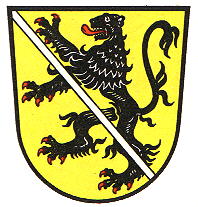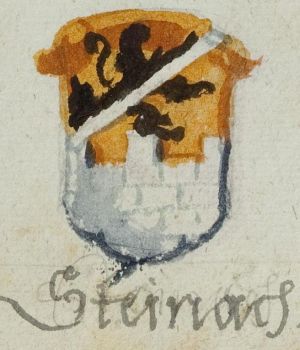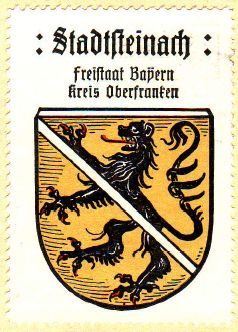Stadtsteinach: Difference between revisions
Knorrepoes (talk | contribs) m (Text replacement - "{{de}}" to "") |
Knorrepoes (talk | contribs) m (Text replacement - "|'''English''' ↵| {{blazon wanted}}↵" to "|'''English''' | blazon wanted ") |
||
| Line 17: | Line 17: | ||
|- | |- | ||
|'''English''' | |'''English''' | ||
| | | blazon wanted | ||
|} | |} | ||
Revision as of 12:31, 7 April 2023
STADTSTEINACH
State : Bayern
District (Kreis) : Kulmbach (until 1973 Stadtsteinach)
Additions : 1971 Triebenreuth, Vogtendorf, Zaubach; 1974 Schwand (partly)
| German |
In Gold ein mit einer silbernen Schrägleiste überdeckter, rot bewehrter schwarzer Löwe. |
| English | blazon wanted |
Origin/meaning
The arms were officially granted on April 12, 1951.
Stadtsteinach was a possession of the bishops of Bamberg and received city rights in the early 14th century. The arms show the arms of the Bishops of Bamberg. These already appeared on the oldest seals of the city dating from the late 14th century. All later seals until 1819 showed the same shield. In the roll of arms of Siebmacher from the early 17th century, the lion was standing on a city wall. This composition was also shown by Hupp in the late 19th century. In 1956 the city officially decided that the wall was no part of the arms.
From 1819-1836, the city used completely different arms, showing a silver chevron in a blue field. Stadtsteinach had become part of Bayern in 1803 and all symbols of the older States were forbidden. The blue and silver were the colours of Bayern, the chevron was most likely arbitrarily chosen.
| The arms in a 16th century manuscript |
The arms by Hupp in the Kaffee Hag albums +/- 1925 |
| The arms in the Deutsches Wappenmuseum |
Literature: Stadler, 1964-1971, 8 volumes.



